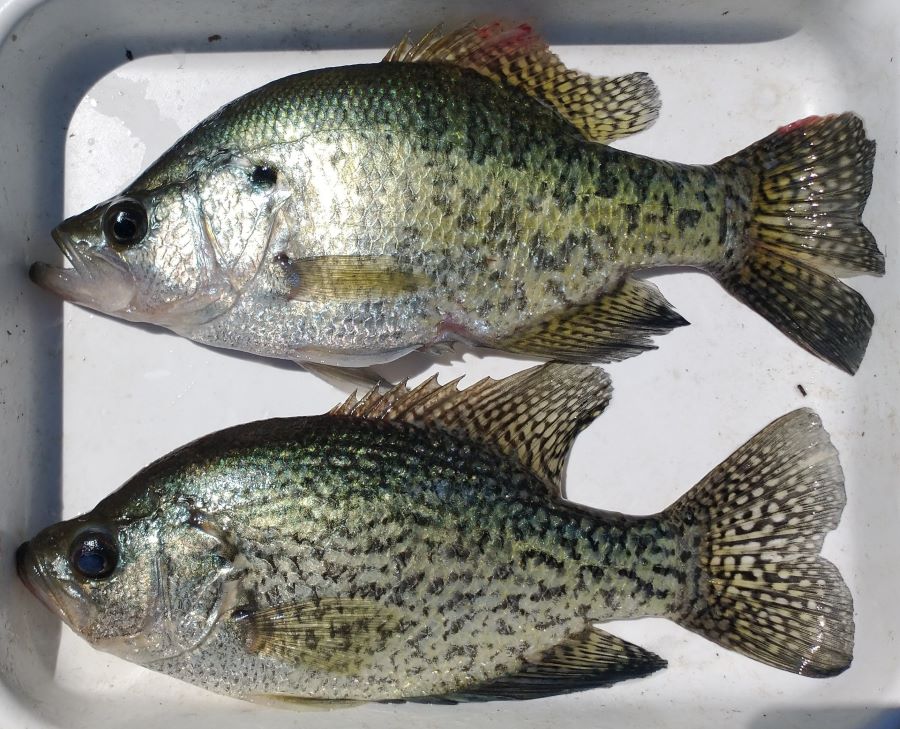No southern freshwater fish is pursued more aggressively for their delicious filets and satisfying fishing quite like crappie, Scott Jones, Extension small impoundment specialist for the University of Arkansas at Pine Bluff, said. From murky backwater cypress swamps in the Delta to deep clear reservoirs in the Ozarks, crappie captivate anglers across the state.
“Naturally, those who own ponds or reservoirs often want to bring this attractive species to their waters,” Jones said. “Unfortunately, replicating large impoundment crappie production in smaller ones can be quite challenging. Thankfully, there are some strategies to increase the odds of successful crappie fisheries in smaller waters.”
Crappie species
Jones said there are two species of crappie, white and black crappie. They look similar but can be differentiated by their hard dorsal fin spines. White crappie have five to six dorsal fin spines, while black crappie have seven to eight. Both species eat zooplankton and insect larvae as fingerlings to juveniles and shift to primarily eating small fish as adults.
“Both species are known for prolific but inconsistent reproduction,” Jones said. “This can be problematic for small ponds with limited forage and predator controls for crappie populations. Hybrid crappie are becoming an increasingly popular option for small ponds due to their limited reproduction. They are easier to manage but require regular stocking to maintain.”
Stocking in small ponds
Most state agencies discourage stocking crappie in smaller ponds and lakes, Jones said.
“Pond sizes deemed acceptable for stocking crappie vary from 3 to 25 acres depending on who you ask,” he said. “The exact size is not the point – it’s just that the probability of failure increases the smaller the pond gets. In this case, a scenario of failure would be when crappie have overpopulated resulting in stunting of most of the species in the pond to the point that fishing satisfaction is ruined because of their small size. Another possible scenario could be that crappie are unable to sustain their population, and the species fails to persist.”
There are examples of small ponds producing satisfying – sometimes excellent – crappie populations, sometimes thanks to wise and diligent management, and other times due to simple luck. However, these situations are difficult to maintain and are often short-lived. There are many more examples of crappie ultimately harming small pond fisheries, which is why they are more often discouraged.
Which species of crappie?
Slight differences make black crappie the preferred choice for smaller bodies of water, Jones said. Black crappie are more willing to eat a diverse diet including insects and larvae, which are often abundant in healthy ponds. White crappie tend to stick to feeding on small fish, increasing pressure on limited forage fish supplies in smaller systems. Also, black crappie reproduction is more stable than white crappie, allowing them to persist without overpopulating more consistently than white crappie.
“If you are unsure about crappie in your small pond, especially those less than a few acres, hybrid crappie would be the variety to try,” he said. “They do not reproduce much, so they are less likely to overpopulate. In fact, they will eventually cease to exist in your pond if you decide they are not worth keeping around.”
Keys to crappie production success
The main keys to crappie success are fertility, food, habitat and population control, Jones said.
Fertility
“Fertility is a little more complicated than the other elements, because it also requires favorable water chemistry for plankton growth,” he said. “The best way to start is by getting a comprehensive water chemistry evaluation to check chemical, mineral and nutrient levels. The Arkansas Water Resources Center can perform these evaluations with their ‘Fish Pond Package.’”
Landowners should consult with a fisheries specialist for interpretation of the results and any treatments that are needed. If fertilization is required, treatments are made periodically over the growing season to produce and maintain a green plankton bloom.
Food production
“Good fertility leads to good food production,” he said. “Food is best achieved with a variety of forage options. The plankton produced by fertile water is the starting point, supporting larvae and fingerlings of all fish species.”
Small fish such as golden shiner stocked annually at 10 to 50 pounds per acre are potentially required if no other small forage options are available. Fathead minnow are another readily available forage option. They are often stocked with golden shiner but do not get as large. Stocking both species is acceptable anytime, but golden shiner are probably the better option for older ponds with mature fisheries.
Typical fathead stocking rates are the same as golden shiner, 10 to 50 pounds per acre annually for sustaining crappie. Bluegill, the most common forage fish stocked in Arkansas ponds, are readily eaten by crappie. However, bluegill quickly get too large for crappie to eat efficiently so they alone usually do not support great crappie production.
Threadfin shad are excellent crappie forage. Most fish producers that offer threadfin sell them by the truckload which includes 5,000 to 10,000 fish depending on their size. The most common stocking rate is about one truckload per 10 acres. Threadfin can overwinter in southern Arkansas ponds, or deeper impoundments in northern Arkansas, however, they may need to be stocked annually due to cold-related winter mortality.
Habitat
Habitat can come in as many shapes and sizes as one’s imagination and resources allow, Jones said. Discarded Christmas trees, downed trees on the property, aquatic vegetation, stacks of old shipping pallets, bundles of bamboo secured in poured concrete blocks, assembled PVC and plastic plumbing pipe structures, and commercially-available artificial fish habitats can all provide congregation zones for periphyton, forage fish, crappie and other sportfish.
“A general rule of thumb is to occupy 20 to 30 percent of the total pond area with habitat,” Jones said.
Population control
Keeping the crappie population under control is the final step in achieving and maintaining a successful crappie fishery, Jones said. A predator species like largemouth bass or hybrid striped bass is
important for consuming large amounts of young crappie, especially in the case of reproducing black and white crappie.
“Adult crappie numbers are controlled by aggressive angler harvest,” he said. “In most situations, harvesting every crappie caught large enough to filet is beneficial. There is usually not enough sustained fishing pressure on private ponds and lakes to harm crappie fisheries. Limiting the population is all based on resource allocation.”
Generally, lower population abundance results in faster growth and larger sizes. There are limited resources to go around, so every additional crappie added to the system reduces the share of the forage and habitat available to each crappie. If allowed to reproduce unchecked, resources are spread too thin and crappie, as well as the other fish in the pond, become stunted and grow very slowly. When this happens, draining the pond and restarting from scratch is often the best solution – an unpleasant, costly and time-consuming endeavor.
Summary
Less is known about crappie in ponds than the typical bass and bluegill combinations, for which there are decades of research and experience to reference, Jones said.
“This increases the importance of adaptive management, where you introduce the crappie and adjust your management approach (stocking, harvest, habitat, etc.) based on the observed changes,” he said. “This requires more diligent fishery assessments to track changes, whether done by yourself or handled by private pond/lake management companies. Speak with a fisheries specialist for guidance on your specific situation and goals.”
The University of Arkansas at Pine Bluff offers all its Extension and Research programs and services without regard to race, color, sex, gender identity, sexual orientation, national origin, religion, age, disability, marital or veteran status, genetic information, or any other legally protected status, and is an Affirmative Action/Equal Opportunity Employer.
About the University of Arkansas at Pine Bluff The University of Arkansas at Pine Bluff (UAPB) is an 1890 Land-Grant HBCU with a diverse student population, competitive degree offerings and stellar faculty. For over 150 years, UAPB has worked to create an environment that emphasizes learning, growth and productivity while affording a basic need to its students: a chance to advance. UAPB offers certificate and associate degree programs, more than 50 undergraduate and master’s degree programs, and a doctoral program in Aquaculture/Fisheries. Students are active in more than 100 organizations, including an internationally renowned Vesper Choir, Marching Musical Machine of the Mid-South (M4) Band, Concert Bands, Wind Symphony and an accomplished athletics program.
Contact Information:
Name: Will Hehemann
Title: Extension Specialist – Communications
University of Arkansas at Pine Bluff – School of Agriculture












